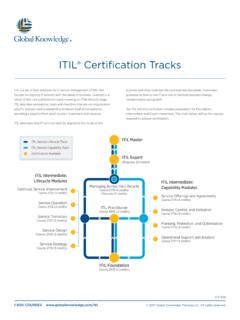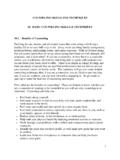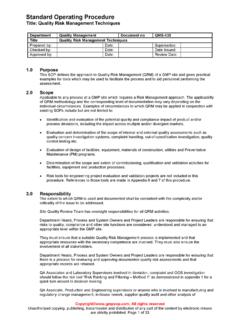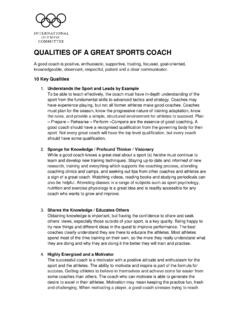Transcription of Tools and
1 1-800-COURSES Expert Reference Series of White Papers Tools and Techniques Useful in quality Planning, assurance , and Control Copyright 2016 Global Knowledge Training LLC. All rights reserved. 2 The Tools and Techniques Useful in quality Planning, assurance , and Control Tim McClintock, Global Knowledge Senior Instructor Introduction The Project Management Institute s (PMI s ) best practices related to quality are all founded firmly in: the quality theories of W. Edwards Deming, Joseph M. Juran, and Phillip Crosby; International Organization for Standardization (ISO) approach to quality management; and well-known quality approaches such as total quality management (TQM), Six Sigma, voice of the customer (VOC), and failure mode and effects analysis (FMEA) design reviews. Modern quality management and project management are complementary, they both emphasize customer satisfaction.
2 quality leads to customer satisfaction. The main objective in quality management is making sure that the project meets the needs that it was originally created to meet nothing more, nothing less. In other words, to ensure quality you must meet the needs of the stakeholder. Meeting or exceeding requirements, on the other hand, is not part of project quality management. According to the PMBOK Guide, quality is the degree to which a set of inherent characteristics fulfill requirements. The project manager and project management team have a special responsibility to balance quality and grade (a category or rank assigned to products or services having the same functional use but different technical characteristics) to ensure that quality expectations are met. This means that it might be possible and reasonable to have a quality , low-grade product, but it is never acceptable to have a low- quality product.
3 At the beginning of the project, requirements are determined with the stakeholders. These requirements become the foundation for the work of the project. After that, the project manager s job is to ensure that the agreed work is done, no extras included. quality is not about giving the customer extras, which are often based on possibly erroneous perceptions of what you believe the customer wants. These extras add time, possibly costs, and other impacts to a project, but do not always result in increased customer satisfaction. Project quality management consists of three major processes: 1. Plan quality management: identifying the quality requirements and standards for the project and product (planning process group). 2. Perform quality assurance : auditing the quality requirements and quality control results to ensure that appropriate quality standards are used (executing process group).
4 3. Control quality : monitoring and recording the results of quality activities to assess performance and recommend necessary changes (monitoring and controlling process group). The definition of quality is central to understanding these three processes. To be able to define quality , you need to be clear about the meaning of the following terms: Validation: assurance that the product meets the agreed-upon needs Verification: compliance with requirements Precision: repeatable measures in a tight grouping Copyright 2016 Global Knowledge Training LLC. All rights reserved. 3 Accuracy: closeness of a measure to the true value Tolerance: range of acceptable results The quality management planning process determines the quality standards that are applicable to the project and devising a way to satisfy them. The goal is to create a quality management plan which documents the following: the way the team will implement the quality policy the way the quality of both the project and the product will be assured during the project the resources required to ensure quality the additional activities necessary to carry out the quality plan Identification of these items might require updates to the project management plan or schedule, emphasizing the evolving nature of the plan and project documents.
5 The plan, like other components created during the planning phase, is written by the project manager with input from stakeholders. When planning for quality on a project follow the corporate quality policies that are in place. If a corporate quality policy does not exist, the project team should create one for the project. The project team might even need to adapt an existing policy to better suit the nature of the project. quality Planning Tools and Techniques Various Tools and techniques are employed on each of these three major processes. Cost-Benefit Analysis The cost-benefit analysis is similar to a cost-benefit ratio. The costs and benefits are measured to analyze the trade-offs of providing quality . Cost of quality Cost of quality (COQ) includes all the costs that conform to the required quality of the project, including the cost to ensure conformance to requirements as well as the cost of nonconformance, and finding the right balance.
6 Modern quality management philosophy emphasizes preventing mistakes rather than detecting them later because the cost of nonconformance is very high. The following costs are associated with quality : Prevention costs are associated with keeping defective products away from the customer. Examples include quality training, quality planning, reliability engineering, test engineering, or data analysis. Appraisal costs are associated with checking the product to make sure it is conforming, such as inspection, testing, calibration, studies, or surveys. Failure costs can be categorized in a couple of ways: o Internal: Nonconformance that is found while the product is still within the performing organization is called internal failure costs, and includes rework or scrap. o External: Nonconformance that is found when the product has been given to the customer is called external failure costs, and includes repair or returns.
7 The cost of nonconformance can also be classified as direct or indirect: o Direct: Direct failure costs include scrap, warranty costs, rework, engineering changes, liability insurance, or inventory costs. o Indirect: Indirect failure costs include fewer sales, lost customers, increased costs to get customers back, decreased team morale, or decreased project efficiency. Copyright 2016 Global Knowledge Training LLC. All rights reserved. 4 Additional Planning Tools A wide variety of other Tools can be applied to quality planning. The PMBOK Guide identifies the following examples: Brainstorming is a technique for gathering information, where multiple unfiltered inputs and ideas are solicited and captured for later analysis and decision making. Force field analysis (FFA) is a technique for analyzing ideas by grouping characteristics or factors that are for (pros) and against (cons) the idea.
8 Nominal group technique (NGT) is an enhancement of brainstorming that adds mechanisms for ranking ideas. It is based on the assumption that a nominal group (one that has agreed to work as a team) will produce better results than a group engaging in traditional brainstorming. NGT collects anonymous input from group members and encourages discussion of all input. Then each member prioritizes the input items. The items are further prioritized based on their cumulative score. quality Control The goal of controlling quality is referenced in the 5th edition of the PMBOK Guide by the control quality process. According to the PMBOK Guide, the control quality process is defined as the process of monitoring and recording the results of executing the quality activities to assess performance and recommend necessary changes. In other words, quality control focuses on project results ensuring that they comply with the quality standards defined for the project and eliminating any causes of unsatisfactory performance.
9 This process measures the details of the product results, such as deliverables or defects, and also of the project management results, such as schedule. The PMBOK Guide acknowledges that often a specialized organizational unit with specific expertise in quality control performs quality control. Many of the techniques under the control quality process assume a working knowledge of statistical quality control, in particular the concepts of sampling and probability. The distinctions between attribute and variable sampling, precision and accuracy, and tolerance and control limits are fundamental components of a working knowledge of statistical quality control: Prevention aids in identifying and avoiding potential problems so that they never enter or impact the process. Inspection helps to identify and eliminate or correct errors so that they are not delivered to the customer.
10 Tolerance is a range of acceptable performance or results. Tools Useful in Both quality Planning and Control quality There are seven basic quality Tools identified as appropriate for use in both the quality management plan and control quality processes. They are known as Ishikawa s seven basic Tools of quality : cause-and-effect diagrams, flowcharting, check sheets, Pareto diagrams, control charts, histograms and scatter diagrams. Ishikawa s seven basic Tools are also referred to as the 7QC Tools . Copyright 2016 Global Knowledge Training LLC. All rights reserved. 5 Cause and Effect Diagrams Cause-and-effect diagrams, or Ishikawa diagrams, were developed by Kaoru Ishikawa to illustrate and help determine how various factors relate to potential problems. Cause-and-effect diagrams are also called fishbone diagrams because they resemble the skeleton of a fish.







